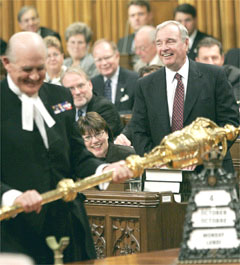State Opening of Parliament
|
|

In the United Kingdom, the State Opening of Parliament is an annual event held usually in October or November that marks the commencement of a session of Parliament. It is held in the House of Lords Chamber after Parliament first assembles in consequence of a General Election and each November thereafter.
The State Opening is a lavish ceremony. First, the cellars of the Palace of Westminster are searched in order to prevent a modern-day Gunpowder Plot. The Plot of 1605 involved a failed attempt by English Catholics to blow up the Houses of Parliament and kill the Protestant king and aristocracy. Since that year, the cellars have been searched, but for the sake of form only.
The Queen arrives at the Palace of Westminster in a horse-drawn coach, entering through Sovereign's Entrance under the Victoria Tower. Then, after she takes on the Royal Robes and the Imperial State Crown in the Robing Chamber, the Queen enters the Lords Chamber and takes a seat at the Throne. The ceremony is traditionally held in the Lords Chamber rather than in the Commons Chamber due to a custom initiated in the seventeenth century. In 1642, King Charles I entered the Commons Chamber and attempted to arrest five members. The Speaker famously defied the King, refusing to inform him as to where the members were hiding. Ever since that incident, no monarch has entered the House of Commons.
Once on the Throne, the Queen, wearing the Imperial State Crown, orders the Gentleman Usher of the Black Rod to summon the Commons. As Black Rod approaches the doors to the Chamber of the Commons, they are closed in his face—symbolically to show the independence of the Lower House. Black Rod then strikes three times with his staff (from which he derives his name), and in reply to the challenge "Who is there?" answers "Black Rod". He is then admitted and issues the summons of the monarch to attend. It is common for one or two senior Members of Parliament to even heckle Black Rod at this time. The ritual indicates the Commons right to deliberate independently of the monarch.
The Commons then arrive at the Bar of the House of Lords (no person who is not a member of the Upper House may pass the Bar unbidden when it is in session; a similar rule applies to the Commons), where they bow to the Queen. Instead of entering the Chamber, the Commons remain at the Bar for the Speech. The Queen reads a prepared speech (known as the Speech from the Throne or the Queen's Speech) outlining the government's agenda for the coming year. The speech is not written by the Queen, but rather the party in power in the House of Commons. Following the Speech, the Commons bow again and return to their Chamber.
After the Queen leaves, each Chamber proceeds to the consideration of an "Address in Reply to Her Majesty's Gracious Speech." But first, each House considers a bill pro forma to symbolize their right to deliberate independently of the monarch. In the House of Lords, the bill is called the Select Vestries Bill, while the Commons equivalent is the Outlawries Bill. The Bills are considered for the sake of form only, and do not make any actual progress.
A very similar ceremony is held in some Commonwealth realms where there are two houses of parliament, such as Canada and Australia, but the Governor-General is usually present and reads the Speech from the Throne, not the Queen.
The debate on the Address in Reply is spread over several days. On each day, a different topic, such as foreign affairs or finance, is considered. The debate provides an indication of the views of the Parliament regarding the government's agenda.
